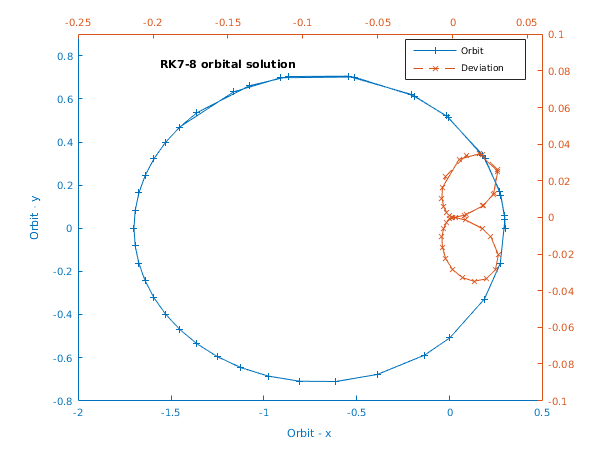
None.
Open in the MATLAB editor: d02pw_example
function d02pw_example fprintf('d02pw example results\n\n'); % Initialize variables and arrays. neq = int64(4); lenwrk = int64(32*neq); method = int64(3); ecc = 0.7; tstart = 0.0; ystart = [1.0-ecc; 0.0; 0.0; sqrt((1.0+ecc)/(1.0-ecc))]; tend = 6.0*pi; thres = [1e-10; 1e-10; 1e-10; 1e-10]; task = 'Complex Task'; % tell d02pv to use d02pd. errass = false; hstart = 0.0; % We run through the calculation twice: once to output the results at % a collection of points, and again to accumulate a series of results for % plotting. nstep = [6; 96]; % Prepare to accumulate results. The first and last points should be the % same - i.e. so the plot shows a closed trajectory. xarray = zeros(nstep(2)+1, 1); yarray = zeros(nstep(2)+1, 4); for icalc = 1:2 tinc = tend/nstep(icalc); % For each calculation, use two tolerances; % plot results corresponding to the second one. tol = [1.0e-4; 1.0e-5]; for itol = 1:2; istep = 1; twant = tinc; % d02pv is a setup routine to be called prior to d02pd. [work, ifail] = d02pv( ... tstart, ystart, twant, tol(itol), thres, method, ... task, errass, lenwrk, 'neq', neq, 'hstart', hstart); if icalc == 1 % Output initial results. fprintf('Calculation with tol = %1.1e\n\n',tol(itol)); fprintf(' t y1 y2 y3 y4\n'); fprintf(' %6.3f', tstart); for ieq = 1:neq fprintf(' %8.4f', ystart(ieq)); end fprintf('\n'); else % Store current results. xarray(1) = tstart; for ieq = 1:neq yarray(1, ieq) = ystart(ieq); end end tnow = 0.0; while tnow < tend if icalc == 1 % For the first calculation, keep integrating till the % (current value for the) endpoint is reached. while tnow < twant [tnow, ynow, ypnow, work, ifail] = ... d02pd( ... @f, neq, work); end % Output current result. fprintf(' %6.3f', tnow); for ieq = 1:neq fprintf(' %8.4f', ynow(ieq)); end fprintf('\n'); else % For the second calculation, just take a single step. [tnow, ynow, ypnow, work, ifail] = ... d02pd( ... @f, neq, work); % Store current result. xarray(istep+1) = tnow; for ieq = 1:neq yarray(istep+1, ieq) = ynow(ieq); end end % Update the endpoint, and call d02pw to reset it. istep = istep + 1; twant = istep*tinc; [ifail] = d02pw(twant); end if icalc == 1 % d02py is a diagnostic routine. [totfcn, stpcst, waste, stpsok, hnext, ifail] = ... d02py; fprintf(['\nCost of the integration in evaluations of ', ... 'F is %1.0f\n\n\n'], totfcn); end end end % Use the first two components of the solution, and calculate the deviation % from a true ellipse. x = yarray(:,1); y = yarray(:,2); xdev = zeros(nstep(2)+1, 1); ydev = zeros(nstep(2)+1, 1); for i = 1:nstep(2)+1 fac = abs((x(i) + ecc)*(x(i) + ecc) + y(i)*y(i)/(ecc*ecc) - 1.0); xdev(i) = fac*cos(xarray(i)); ydev(i) = fac*sin(xarray(i)); end % Plot results. fig1 = figure; display_plot(x, y, xdev, ydev); function [yp] = f(t, y, yp) % Evaluate derivative vector. yp = zeros(4, 1); r = sqrt((y(1)^2 + y(2)^2)); yp(1) = y(3); yp(2) = y(4); yp(3) = -y(1)/r^3; yp(4) = -y(2)/r^3; function display_plot(x1, y1, x2, y2) % Plot the results. First, get the list of default colours (we have to % specify the plot colours by hand). axes('XLim', [-2 0.5], 'YLim', [-0.8 0.9]); cols = get(gca, 'ColorOrder'); % Plot the first curve. hline1 = line(x1, y1, 'Color', cols(1,:)); ax1 = gca; set(ax1, 'XColor', cols(1,:), 'YColor', cols(1,:)); % Label these axes. xlabel('Orbit - x'); ylabel('Orbit - y'); % Set up the second set of axes and plot the second curve. ax2 = axes('Position', get(ax1,'Position'), ... 'XAxisLocation', 'top', 'YAxisLocation', 'right', ... 'Color','none', 'XColor',cols(2,:), 'YColor', cols(2,:), ... 'XLim', [-0.25 0.06], 'YLim', [-0.1 0.1]); hline2 = line(x2, y2, 'Color', cols(2,:), 'Parent', ax2); % Label these axes. h = title('RK7-8 orbital solution'); set(h,'Position',[-0.15,0.08]); % Add a legend, specifying the lines explicitly. legend([hline1, hline2],'Orbit','Deviation','Location','Best'); % Set some features of the two lines. set(hline1, 'Linewidth', 0.25, 'Marker', '+', 'LineStyle', '-'); set(hline2, 'Linewidth', 0.25, 'Marker', 'x', 'LineStyle', '--');
d02pw example results Calculation with tol = 1.0e-04 t y1 y2 y3 y4 0.000 0.3000 0.0000 0.0000 2.3805 3.142 -1.7000 0.0000 -0.0000 -0.4201 6.283 0.3000 -0.0000 0.0001 2.3805 9.425 -1.7000 0.0000 -0.0000 -0.4201 12.566 0.3000 -0.0003 0.0016 2.3805 15.708 -1.7001 0.0001 -0.0001 -0.4201 18.850 0.3000 -0.0010 0.0045 2.3805 Cost of the integration in evaluations of F is 571 Calculation with tol = 1.0e-05 t y1 y2 y3 y4 0.000 0.3000 0.0000 0.0000 2.3805 3.142 -1.7000 -0.0000 0.0000 -0.4201 6.283 0.3000 0.0000 -0.0000 2.3805 9.425 -1.7000 0.0000 -0.0000 -0.4201 12.566 0.3000 -0.0001 0.0004 2.3805 15.708 -1.7000 0.0000 -0.0000 -0.4201 18.850 0.3000 -0.0003 0.0012 2.3805 Cost of the integration in evaluations of F is 748
